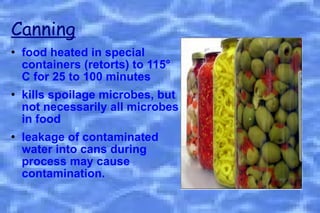The Term Radappertization Is Used to Describe Food Preservation by
In addition to making foods more tender and palatable cooking destroys a large proportion of the microorganisms and natural enzymes in. Radicidation involves doses of less than 1 kilogray for extending shelf life and inhibiting sprouting.

Food Irradiation Is Safe Food Microbiology Academy
Which of the following represents a different principle for food preservation.

. Dehydration is the method of food preservation used for meat jerky dried fruit or fruit leathers and herbs. Other Apps - April 15 2022 Solids Post a Comment Read more The Term Radappertization Is Used to Describe Food Preservation by. No microbial spoilage or toxicity should become detectable in a food so treated regardless of the.
Treatment of food with a large enough dose of irradiation usually. A major chemical used to preserve meat products is. Radappertization is a dose in the range of 20 to 30 kilograys necessary to sterilize a food product.
The radiation used for food preservation is normally gamma radiation from radioactive isotopes or machine-generated x rays or electron beams. Chapter 34 - Microbiology of Food Chapter 34 Microbiology of Food Multiple Choice Questions 1. Radappertization is a form of food irradiation which applies a dose of ionizing radiation sufficient to reduce the number and activity of viable microorganisms to such an extent that very few if any are detectable in the treated food by any recognized method viruses being excepted.
The term radappertization is used to describe food preservation by. Food preservation includes food processing practices which prevent the growth of microorganisms such as yeasts although some methods work by introducing benign bacteria or fungi to the food and slow the oxidation of fats that cause rancidityFood preservation may also include processes that inhibit visual deterioration such as the enzymatic browning reaction in. Chemical preservation involves adding specific ingredients to foods and food packaging that allows the food to remain safe and fresh.
Articleosti_5706967 title Injury and destruction of Moraxella-Acinetobacter in the radappertization process. Preservation ensures that the quality edibility and the nutritive value of the food remains intact. The swelling of a food-containing can is usually due to the production of ___ by spoilage microbes.
Radurization is a dose of 1 to 10 kilograys that like pasteurization is useful for targeting specific pathogens. The type of radiation of primary interest in food preservation is electromagnetic. Of the various means of preserving foods the use of eat finds very wide application.
The term radappertization is used to describe food preservation by. Modern methods of dehydration use circulating air that is heated just enough to promote dehydration without cooking the food. Food and Drug Administration FDA in 1983.
The principle behind all these methods is either to reduce the temperature conditions required for microbial growth or to evaporate the water content. The UV rays X rays gamma rays kill all the unwanted microbes present in food. Addition of salt C.
Is no longer used for food processing in the United States. Other Apps - April 10 2022 Food Irradiation Is Safe Food Microbiology. The process also ensures that there is no discolouration or aging.
Food preservation by pulsed electric fields is a standard reference for all those involved in research into PEF food processing and its commercialisation. Off Grid Food Preservation Techniques You Need To Know Food Low Cost Meals Food Store The radiation used for food preservation is normally gamma radiation from radioactive isotopes or machine-generated x rays or electron beams. Sometimes ____ beams are used to irradiate foods in place of gamma radiation because the process does not generate radioactive waste.
Which of the following represents a different principle for food preservation. The term radappertization is used to describe food preservation by _____. The bonus of sunlight is ultra violate rays which also serve to kill microbes.
One of the first applications of radiation for food preservation was in the treatment of various kinds of herbs and spices an application approved by the US. Preservation also involves sealing to prevent. This method is also known as cold sterilization.
Describe a Network Solid and Give Two Examples. Initially the destruction of microorganisms in foods by ionizing radiation was referred to. Preservation involves preventing the growth of bacteria fungi and other microorganisms as well as retarding oxidation of fats to reduce rancidity.
Treatment with high doses of ionizing irradiation 10 kGy is termed radappertization a process intended to be used for preparing commercially sterile food products 98. The simple acts of cooking frying broiling or otherwise heating foods prior to consumption are forms of food preservation. Final Report Apr 78-1 May 80 author Maxcy R B and Rowley D B abstractNote Some highly radiation-resistant Moraxella-Acinetobacter M-A may survive the radappertization process for meat preservation because these vegetative bacteria are more.
Humans have been using chemical preservation for thousands of years and familiar food products such as yogurt sauerkraut and kimchi are examples of foods that have undergone chemical preservation. A major organism considered to. View Chap034 from BIOL 2421 at Dallas County Community College.

There Are Many Potential Methods You Can Utilize When It Comes To Food Preservation Visit The Link To Learn Methods Of Food Preservation Food Preserving Food

Food Preservation By Use Of Radiation Em Radiations Of Importance In Food Preservation The Em Radiations Of Importance In Food Preservation Are Ultra Ppt Download
Comments
Post a Comment